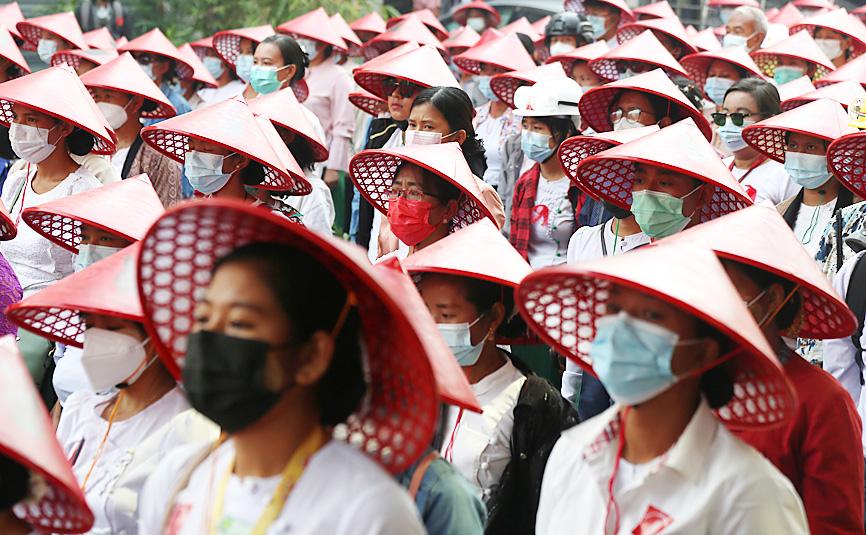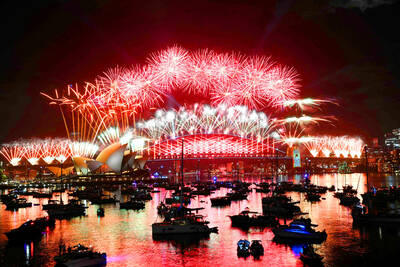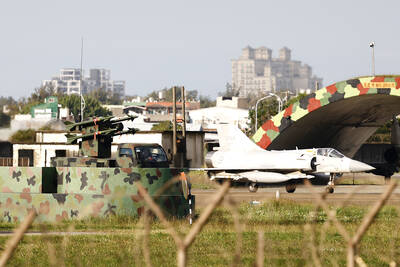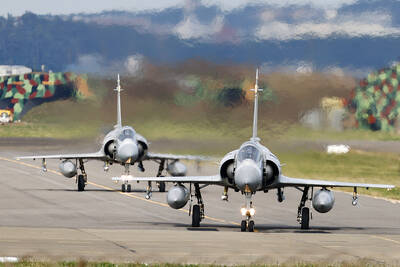At least 10 people were killed yesterday when Burmese security forces fired on protesters of a military coup as multiple rallies across the nation descended into chaos.
Myanmar has been in an uproar since Feb. 1 when the military launched a coup and detained civilian leader Aung San Suu Kyi, ending the nation’s decade-long experiment with democracy and sparking daily mass protests.
International pressure is mounting — Western powers have repeatedly hit the generals with sanctions — and the UK has called for a UN Security Council meeting tomorrow.

Photo: Reuters
However, the junta has ignored the global condemnation, responding to the uprising with escalating strength, and security services used lethal force on demonstrators again yesterday.
Three cities in central Myanmar saw bloody crackdowns on protesters by security forces, with Monywa in the Sagaing region registering the highest number of deaths with at least seven.
“What we can confirm is seven people have died,” said an emergency doctor, who declined to provide his name.

Photo: EPA-EFE
Multiple medics also said they saw two other people being dragged away by security forces, although they could not get close enough to confirm if they had died.
In Mandalay, the second largest city in Myanmar, two demonstrators were killed, a doctor said, adding that one of the victims was 19 years old and was shot in the head.
A protest in Myingyan also turned deadly when security forces deployed tear gas, rubber bullets and live rounds against protesters carrying red home-made shields emblazoned with the three-finger salute — a symbol of resistance for the anti-coup movement.
Several medics confirmed a young man was gunned down.
“Zin Ko Ko Zaw, a 20-year-old, was shot dead on the spot,” a rescue team member said, adding that his team had treated 17 people from the protest.
Local media in Kachin state reported similar scenes of violence, publishing images of police bearing down on protesters in Hpakant.
“Some were hit with rubber bullets and some were suffocating because of tear gas,” a doctor said, adding that his private hospital treated 10 injured people.
Two critically wounded people — one struck in the chest, the other in the neck — had to be driven to the state capital’s hospital about four hours away.
Parts of commercial hub Yangon were transformed, with protesters using makeshift tires and barbed wire barricades to block major roads.
Near the famed Sule pagoda intersection, protesters pasted printouts of Burmese Army Senior General Min Aung Hlaing’s face on the ground — a tactic aimed at slowing security forces, who will avoid standing on the portraits.
In San Chaung township, which has been the site of intense clashes in recent days, tear gas and fire extinguisher clouds filled the streets as riot police confronted protesters, while a clash in Yangon’s outskirts left at least 19 people injured.

Taiwan is gearing up to celebrate the New Year at events across the country, headlined by the annual countdown and Taipei 101 fireworks display at midnight. Many of the events are to be livesteamed online. See below for lineups and links: Taipei Taipei’s New Year’s Party 2026 is to begin at 7pm and run until 1am, with the theme “Sailing to the Future.” South Korean girl group KARA is headlining the concert at Taipei City Hall Plaza, with additional performances by Amber An (安心亞), Nick Chou (周湯豪), hip-hop trio Nine One One (玖壹壹), Bii (畢書盡), girl group Genblue (幻藍小熊) and more. The festivities are to

Auckland rang in 2026 with a downtown fireworks display launched from New Zealand’s tallest structure, Sky Tower, making it the first major city to greet the new year at a celebration dampened by rain, while crowds in Taipei braved the elements to watch Taipei 101’s display. South Pacific countries are the first to bid farewell to 2025. Clocks struck midnight in Auckland, with a population of 1.7 million, 18 hours before the famous ball was to drop in New York’s Times Square. The five-minute display involved 3,500 fireworks launched from the 240m Sky Tower. Smaller community events were canceled across New Zealand’s

‘IRRESPONSIBLE’: Beijing’s constant disruption of the ‘status quo’ in the Taiwan Strait has damaged peace, stability and security in the Indo-Pacific region, MOFA said The Presidential Office yesterday condemned China’s launch of another military drill around Taiwan, saying such actions are a “unilateral provocation” that destabilizes regional peace and stability. China should immediately stop the irresponsible and provocative actions, Presidential Office spokeswoman Karen Kuo (郭雅慧) said, after the Chinese People’s Liberation Army (PLA) yesterday announced the start of a new round of joint exercises around Taiwan by the army, navy and air force, which it said were approaching “from different directions.” Code-named “Justice Mission 2025,” the exercises would be conducted in the Taiwan Strait and in areas north, southwest, southeast and east of Taiwan

UNDER WAY: The contract for advanced sensor systems would be fulfilled in Florida, and is expected to be completed by June 2031, the Pentagon said Lockheed Martin has been given a contract involving foreign military sales to Taiwan to meet what Washington calls “an urgent operational need” of Taiwan’s air force, the Pentagon said on Wednesday. The contract has a ceiling value of US$328.5 million, with US$157.3 million in foreign military sales funds obligated at the time of award, the Pentagon said in a statement. “This contract provides for the procurement and delivery of 55 Infrared Search and Track Legion Enhanced Sensor Pods, processors, pod containers and processor containers required to meet the urgent operational need of the Taiwan air force,” it said. The contract’s work would be